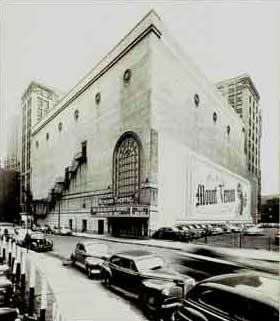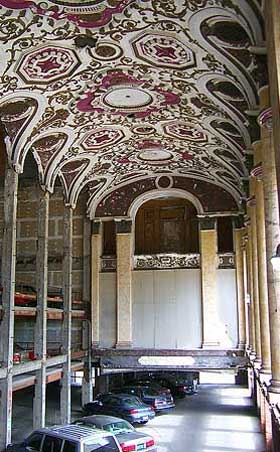




|
|
|
|
|
|
|||
|
|
|||
This single building, more than any other, encapsulates the tale of Detroit during the 20th century. The tale begins, naturally enough, with Henry Ford, who opened his first workshop on this site in 1892. This single storey workshop was the birthplace of the Ford Motor company. Thirty-four years later Ford had all but conquered the world, and Detroit was riding high on the back of this success. The bourgeoning downtown theatre district was catering for the growing population's desire for escape.
In 1926 the Michigan Theatre opened on the site and at seven storeys and 4,000 seats was the biggest in the city. It was built as an addition to the thirteen storey office tower already on the site, and offered an extraordinarily luxurious environment for its movie-going audience. However, after twenty years of sucessful service, audiences had dropped significantly due to the arrival of the television in people's living rooms and the massive migration to the suburbs. Eventually, in 1967, the grand Michigan Theatre closed and was slated for demolition.
Various attempts were made to salvage the theatre; it had brief reincarnations as a porn cinema, a supper club and a rock concert hall, but none of these could be sustained. Yet another victim of the now desperate rush to the suburbs, the theatre was finally abandoned in 1975. By the late seventies there was clearly very little demand for entertainment facilities downtown, but there was still some demand for parking space. Consequently, in 1977, a proposal was made to demolish the building to provide parking space. However this plan was frustrated by the discovery that the adjoining tower was structurally interdependant with the theatre, and the proposal had to be reworked. The consulting engineer then recommended that the shell of the building be retained to provide a secure indoor parking garage. This seems to have been a highly logical solution. The main entry was easily wide enough for the entry and exit of vehicles, whilst the grand staircase was adapted to fit in the curving parking ramp. A simple three-level steel and concrete parking structure was inserted into the 45m by 65m auditorium to provide the required 160 spaces.
|
|
|
|
|
|
|||
|
|
|||

|
On returning from Detroit I heard a rumour that the Michigan is to experience yet another twist of fate. A movie called '8 mile' directed by Curtis Hanson (L.A. Confidential) has recently been filmed in Detroit.
The people of Detroit know 8 Mile as the city limit - a physical and psychological dividing line that separates the decaying downtown from the prosperous suburbs.
The drama features the hip hop culture of the city in 1995 and is a semi-autobiographical account of Detroit's most famous son, and lead actor in the movie, Eminem.
There is a scene in the movie which shows a rave taking place against the backdrop of an otherworldly disused theatre which seems to have been converted into a car park....
So, the Michigan has it's final fling with Hollywood, as a menacing backdrop in a movie about urban decay. If you go and see the movie, look out for it. (8 Mile is released in the US on 8 November 2002) |
Images, from top left: 1. Michigan Theatre in the 1930s 2. Entrance foyer 3. The theatres transformation 4. Upper floor view 5. Historic plaque - the only sign of any concession to nostalgia.
